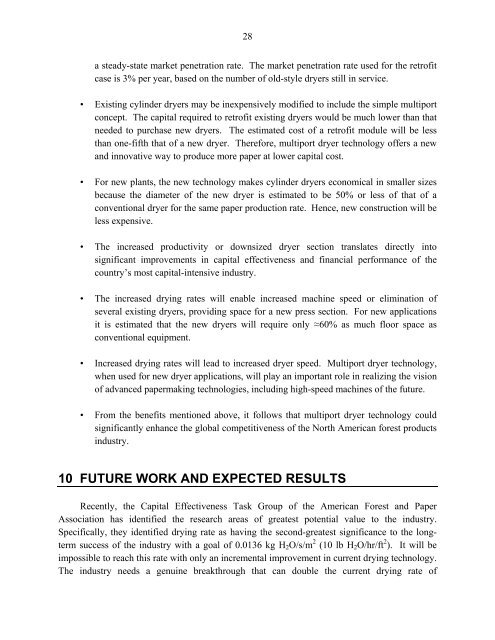final report on the multiport dryer - Argonne National Laboratory
final report on the multiport dryer - Argonne National Laboratory
final report on the multiport dryer - Argonne National Laboratory
You also want an ePaper? Increase the reach of your titles
YUMPU automatically turns print PDFs into web optimized ePapers that Google loves.
28a steady-state market penetrati<strong>on</strong> rate. The market penetrati<strong>on</strong> rate used for <strong>the</strong> retrofitcase is 3% per year, based <strong>on</strong> <strong>the</strong> number of old-style <strong>dryer</strong>s still in service.• Existing cylinder <strong>dryer</strong>s may be inexpensively modified to include <strong>the</strong> simple <strong>multiport</strong>c<strong>on</strong>cept. The capital required to retrofit existing <strong>dryer</strong>s would be much lower than thatneeded to purchase new <strong>dryer</strong>s. The estimated cost of a retrofit module will be lessthan <strong>on</strong>e-fifth that of a new <strong>dryer</strong>. Therefore, <strong>multiport</strong> <strong>dryer</strong> technology offers a newand innovative way to produce more paper at lower capital cost.• For new plants, <strong>the</strong> new technology makes cylinder <strong>dryer</strong>s ec<strong>on</strong>omical in smaller sizesbecause <strong>the</strong> diameter of <strong>the</strong> new <strong>dryer</strong> is estimated to be 50% or less of that of ac<strong>on</strong>venti<strong>on</strong>al <strong>dryer</strong> for <strong>the</strong> same paper producti<strong>on</strong> rate. Hence, new c<strong>on</strong>structi<strong>on</strong> will beless expensive.• The increased productivity or downsized <strong>dryer</strong> secti<strong>on</strong> translates directly intosignificant improvements in capital effectiveness and financial performance of <strong>the</strong>country’s most capital-intensive industry.• The increased drying rates will enable increased machine speed or eliminati<strong>on</strong> ofseveral existing <strong>dryer</strong>s, providing space for a new press secti<strong>on</strong>. For new applicati<strong>on</strong>sit is estimated that <strong>the</strong> new <strong>dryer</strong>s will require <strong>on</strong>ly ≈60% as much floor space asc<strong>on</strong>venti<strong>on</strong>al equipment.• Increased drying rates will lead to increased <strong>dryer</strong> speed. Multiport <strong>dryer</strong> technology,when used for new <strong>dryer</strong> applicati<strong>on</strong>s, will play an important role in realizing <strong>the</strong> visi<strong>on</strong>of advanced papermaking technologies, including high-speed machines of <strong>the</strong> future.• From <strong>the</strong> benefits menti<strong>on</strong>ed above, it follows that <strong>multiport</strong> <strong>dryer</strong> technology couldsignificantly enhance <strong>the</strong> global competitiveness of <strong>the</strong> North American forest productsindustry.10 FUTURE WORK AND EXPECTED RESULTSRecently, <strong>the</strong> Capital Effectiveness Task Group of <strong>the</strong> American Forest and PaperAssociati<strong>on</strong> has identified <strong>the</strong> research areas of greatest potential value to <strong>the</strong> industry.Specifically, <strong>the</strong>y identified drying rate as having <strong>the</strong> sec<strong>on</strong>d-greatest significance to <strong>the</strong> l<strong>on</strong>gtermsuccess of <strong>the</strong> industry with a goal of 0.0136 kg H 2 O/s/m 2 (10 lb H 2 O/hr/ft 2 ). It will beimpossible to reach this rate with <strong>on</strong>ly an incremental improvement in current drying technology.The industry needs a genuine breakthrough that can double <strong>the</strong> current drying rate of
















